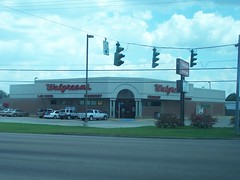New Orleans: The Plot Sickens
 One of the neighborhood planning sessions at last Sunday's kick-off of the selection process for planning teams for the Unified New Orleans Plan. Photo from the People Get Ready blog.
One of the neighborhood planning sessions at last Sunday's kick-off of the selection process for planning teams for the Unified New Orleans Plan. Photo from the People Get Ready blog.(I swiped the title from Karen Gadbois of the Northwest Carrollton blog.)
There is the old saying about Mexico, "Poor Mexico, so far from God, and so close to the United States." Then there is a saying about New Orleans, that it's the northernmost city of the Caribbean. And we could say, it isn't being treated so well by the United States of America either.
Sunday was the big kickoff meeting for the Unified New Orleans Plan, which is intended to be a consolidated city plan, approved by City Planning, and the City Council. After approval, it is sent to the Louisiana Recovery Authority which presents the document to the U.S. Department of Housing and Urban Development, for approval and justification for federal funding.
Even before Katrina, New Orleans had "issues" of poverty, deconcentration, suburban vs. urban regional political and economic power structures, etc. (See work by David Rusk, such as Inside Game, Outside Game.)
Now, New Orleans has all of that plus wrecked infrastructure, a loss of half the city's population, destroyed neighborhoods, and a raised awareness and heightened concerns about about "environmental justice" in terms of race, environment, and the built environment.
These plans are supposed to be created by the end of November and submitted to the New Orleans Planning Commission. They are expected to be approved by City Council next April and May.
It seems pretty accelerated to me.
Many of the New Orleans area blogs are writing about the Sunday meeting. They say that the New Orleans Times-Picayune article, "Planning pros, citizens meet to chart rebirth: Each neighborhood's blueprint to be cog in unified city vision" didn't "fully" cover how the meeting went.
The People Get Ready blog has a lot to say about this issue, many photos, and links to other blogs, such as Adrastos, Michael Homan, and Becky Houtman. See the entry "The Veneer of Public Input."
 A typical suburban Walgreen's in South Louisiana.
A typical suburban Walgreen's in South Louisiana.And the Walgreen's debacle in South New Orleans continues. Apparently Walgreen's is doing the normal thing, pressuring other City Councilmembers to get their way. See the blog entry from The Third Battle of New Orleans for more on this. From the blog:
It is my understanding that instead of following Ms. Midura's instructions, Team Walgreen's approach is to work around her request by playing a little hardball with the other City Council representatives coercing a majority vote in favor of the proposed zoning variance. In my opinion, Walgreen's has absolutely no intention of any compromise despite Ms. Midura's good-faith negotiations. Nearly to the level of contempt Walgreen's appears to be indifferent to the wants, the expectations, or the desires of the adjacent neighborhoods.
Here is a hypothetical example of above-mentioned "hardball," but in an alterno-world New Orleans--unfortunately a New Orleans also flooded by a failed federal flood protection system. Let's say within City Council District X languishes several still-shuttered, flooded-out Floorblue's Drug Stores. District X's councilperson desperately wants at least one or two of the stores to re-open to offer the district's rebuilding constituency some degree of normalcy and to illustrate to the voters of District X that their councilperson is indeed working on their behalf. If Floorblue's conveys to District X Councilperson that those stores will never re-open upon a vote against the proposed controversial zoning variance in District Z, what is District X Councilperson to do? Hmmmmmm--a dilemma.
I just wonder why it is so hard to do the right thing there--for developers and for the cities. (Note that this kind of hardball was played by Giant Supermarket in their seizure of sidewalk on Park Road NW for a driveway. The higher-ups in the city government didn't want to play hardball for fear of losing Giant's not-then-signed commitment to building a supermarket in Ward 8, which no longer has any large supermarkets.)
This reminds of what was done in the H Street area vis-a-vis BP. The project was fought for a long long time. But fortunately, the Office of Planning weighed in with a development review that said the proposal was inappropriate for the site. And because the proposal was for a gas station, a hearing process is required, as this isn't a matter of right use in a C2 zone. So the Board of Zoning Adjustment asked BP to go back and do a community-involved plan.
Granted that many of the local neighborhood bad elements (people with their hands out) inveigled themselves into the process, but the process lasted long enough that the market changed, and it was worth it for the owner of the property to buy BP out of the lease and redevelop the site in another fashion.
New Orleans though, doesn't have that kind of demand for property, except in the most desirable areas--which are just a few places, and not along Carrollton and Claiborne Avenues in South New Orleans. (And hell, even in 2003 you could still find deals on many of the commercial strips in Washington, including H Street NE.)
How does one pressure Walgreen's to do the right thing? Walgreen's has extant stores that are urban-sympathetic, even in New Orleans. But I think it depends on the "quality" of the company's regional real estate executives. That was the problem with BP. We tried to bump it up another level, but despite all the encomiums to Lord Browne, the CEO, and articles in Harvard Business Review about how great the company is and oriented to building community value, that's a crock. We could get no traction with BP.
 Walgreens in Boston, photo by Michael Mehaffey.
Walgreens in Boston, photo by Michael Mehaffey. Walgreens wanted to tear down St. George's Church in Cincinnati for one of their stores, but they were turned back. Photo: National Trust for Historic Preservation.
Walgreens wanted to tear down St. George's Church in Cincinnati for one of their stores, but they were turned back. Photo: National Trust for Historic Preservation.The Park Place blog in Pittsburgh also reports on a neighborhood battle to prevent Walgreen's from redeveloping a commercial site in part by encroaching on a residential zone and demolishing houses. (They look like they need some serious urban design help generally, judging by photos on the blog of their commercial district.)
 Image from the Park Place blog.
Image from the Park Place blog. Photo from the kick-off session for the Unified New Orleans Plan. Photo from the People Get Ready blog.
Photo from the kick-off session for the Unified New Orleans Plan. Photo from the People Get Ready blog.Index Keywords: New Orleans



0 Comments:
Post a Comment
<< Home